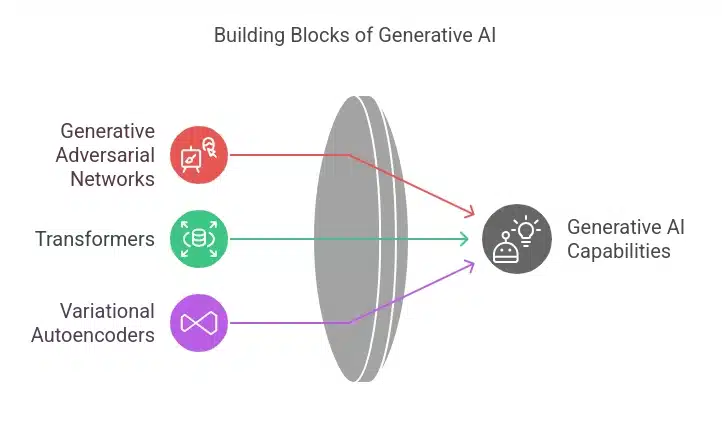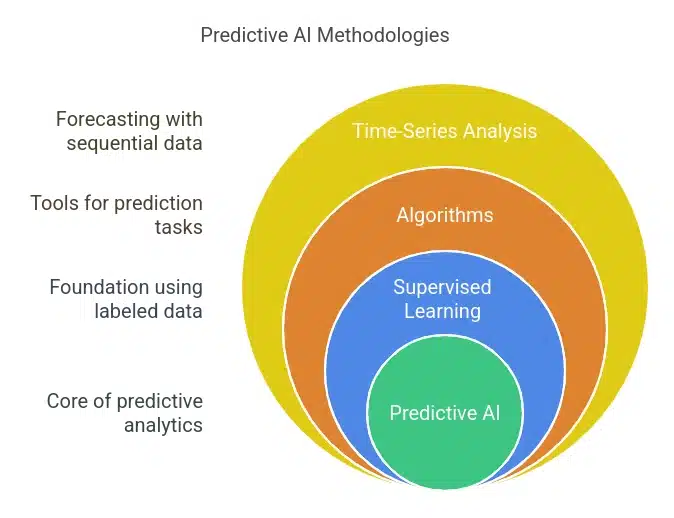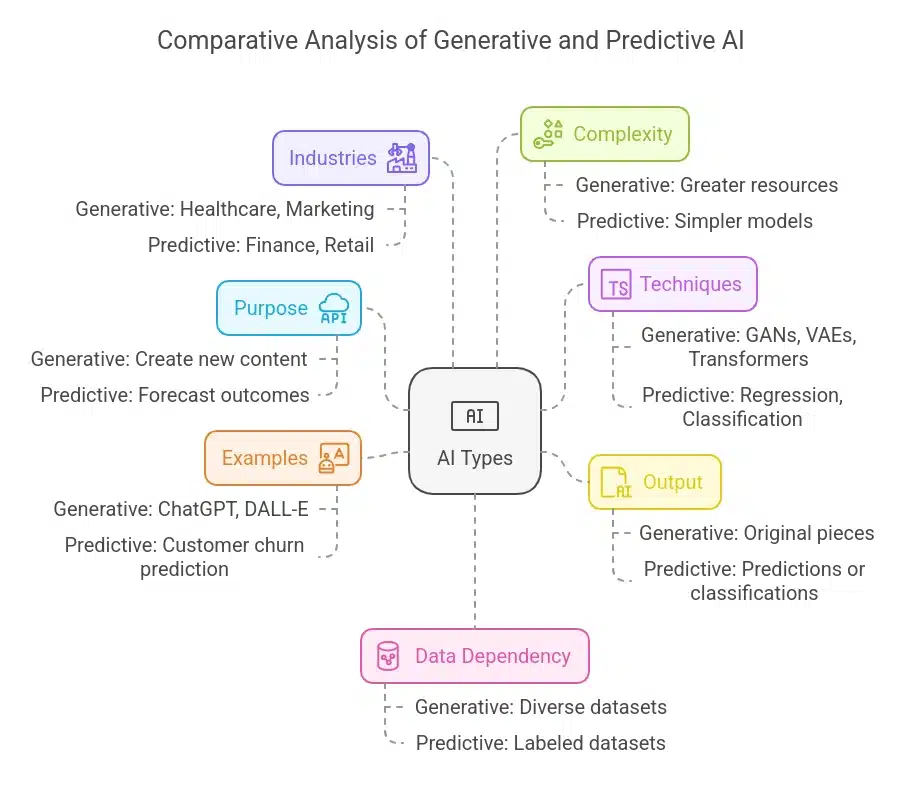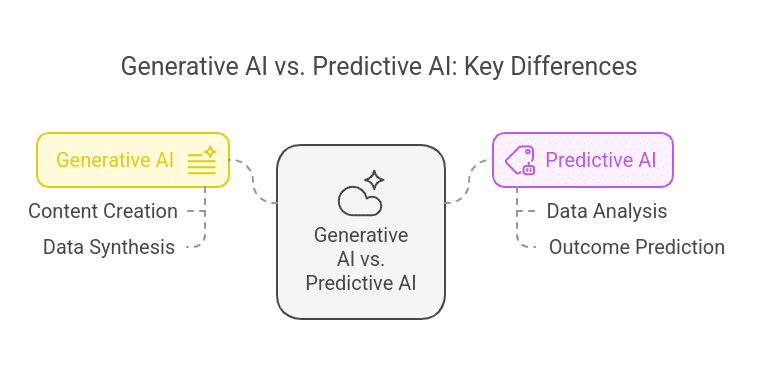- Introduction
- What is Generative AI?
- What is Predictive AI?
- How does Generative AI Work?
- How Does Predictive AI Work?
- Generative AI Applications
- Predictive AI Applications
- Difference Between Generative AI and Predictive AI
- How Generative and Predictive AI Work Together?
- Ethical Considerations
- Conclusion
- Quiz Time
Introduction
Artificial intelligence (AI) revolutionizes our work, lives, and engagement with technology. Two different subfields of AI—Generative AI and Predictive AI—have become essential sources of innovation in the broad field. Although they use data and complex algorithms, their functions are essentially different.
Predictive AI obeys the principle of foreseeing the future. At the same time, generative AI is fed with an algorithmic logic framework for generating new data or pieces of content. In this article, we will explore both Generative AI and Predictive AI, along with their functionalities, differences and real-world examples.
What is Generative AI?
Generative AI is the branch of artificial intelligence that produces new material—be it text, images, audio, or code— by learning patterns from existing data.
By simulating the traits and patterns of the data that they are trained on, these systems produce outputs that appear to be honest and natural.
Learn in detail - what Generative AI is.
What is Predictive AI?
Predictive AI is an area of artificial intelligence focused on forecasting future events or outcomes based on historical or real-time data.
It typically uses algorithms like regression, classification, and time-series analysis to identify patterns and make evidence-based predictions about what will happen next.
The primary purpose of predictive AI is to predict future occurrences or tendencies by evaluating past data and finding patterns. Its essential goal is to create reliable predictions that guide decision-making in several areas.
Learn in detail - what predictive AI is.
How does Generative AI Work?

Generative AI makes use of complex machine learning methods like:
- Generative Adversarial Networks: Generative Adversarial Networks (GANs) consist of two main components: the discriminator and the generator. The discriminator evaluates the output from the generator against real data, which, in turn, helps enhance the quality of the generator's output.
- Transformers: Transformers are the foundation for natural language processing (NLP), including models like GPT (Generative Pre-trained Transformer). They are essential for creating language models such as ChatGPT and excel at producing text that resembles human writing.
- Variational Autoencoders: Variational Autoencoders compress and reconstruct data into a latent space, enabling models to learn essential data features.
Suggested Read: What is Machine Learning?
How Does Predictive AI Work?

Predictive AI is dependent upon:
- Supervised Learning: Labeled datasets with inputs linked with known outcomes are used to train models.
- Regression and Classification: Algorithms like neural networks, decision trees, and linear regression are frequently employed for prediction tasks.
- Time-Series Analysis: Examines successive data to forecast future values, such as sales or stock prices.
Generative AI Applications
- Content Creation
- Tools like ChatGPT generate blog articles, essays, marketing copy, and even social media posts—helping content teams scale up their output.
- Visual Design & Art
- Models such as DALL-E produce original images from text prompts, speeding up creative workflows for branding, advertising, or concept art.
- Synthetic Data Generation
- In industries with limited or sensitive data (e.g., healthcare, finance), generative models create synthetic datasets that preserve privacy while allowing robust model training.
- Virtual Environments & Avatars
- Gaming and VR platforms use generative AI to build immersive worlds or lifelike avatars, enabling more engaging user experiences.
- Personalized Marketing
- By analyzing user preferences, generative AI can craft unique ad creatives or customized product recommendations to boost conversion rates.
- Automated Code Generation
- Advanced generative models can translate plain-language descriptions into functional code snippets, assisting developers with rapid prototyping.
Suggested Read: Generative AI Models
Predictive AI Applications
- Customer Churn Analysis
- Predictive models identify customers likely to discontinue a service, allowing businesses to implement targeted retention strategies.
- Fraud Detection
- Banks and e-commerce platforms use predictive algorithms to spot suspicious transactions or unusual behaviors, preventing financial losses.
- Healthcare & Diagnostics
- Predictive AI assesses patient data to estimate disease progression, outcomes, or treatment efficacy—supporting proactive healthcare decisions.
- Predictive Maintenance
- Manufacturing and IoT systems rely on predictive models to anticipate equipment failures, reducing downtime and extending asset lifespan.
- Demand Forecasting & Supply Chain Optimization
- Retailers and logistics companies employ predictive AI to forecast product demand, optimize inventory levels, and streamline delivery routes.
- Finance & Risk Assessment
- Predictive models evaluate credit risk, forecast stock prices, and guide investment decisions by identifying market trends and anomalies.
Difference Between Generative AI and Predictive AI

| Feature | Generative AI | Predictive AI |
| Purpose | Creates new data or content. | Forecasts future outcomes based on historical data. |
| Techniques | GANs, VAEs, Transformers. | Regression, Classification, Time-Series Models. |
| Output | New images, text, or music. | Predictions or classifications. |
| Examples | ChatGPT, DALL-E, DeepFakes. | Customer churn prediction, fraud detection. |
| Industries | Healthcare, Marketing, Entertainment. | Finance, Retail, Healthcare. |
| Complexity | Requires computational power and complex models. | Often simpler and interpretable models. |
| Data Dependency | Requires diverse datasets for content generation. | Relies on labeled or historical datasets. |
How Generative and Predictive AI Work Together?
Sometimes, Predictive and generative AI work in tandem. For Example:
1. Healthcare:
- Generative AI: Generative AI creates synthetic medical data for uncommon disorders to train models.
- Predictive AI: Predicts how long a patient will heal or how their illness will develop.
2. Marketing:
- Generative AI: Creates individualized ad content tailored to audience preferences.
- Predictive AI: It discloses a certain age group to which the ads are most attractive and consequently most likely to interact with them.
3. Autonomous Vehicles:
- Generative AI: Generative AI provides specific driving situations to help AVs during autonomous training.
- Predictive AI: Predicts traffic patterns and possible risks.
Ethical Considerations
Despite their considerable potential, both generative and predictive AI can pose moral and societal challenges. Addressing these issues requires balancing innovation with accountability.
Challenges with Generative AI
- DeepFakes & Misinformation
- AI-generated images or videos can distort reality, spreading false information.
- Copyright Concerns
- Authorship and intellectual property rights become murky when content is produced by algorithms rather than humans.
Challenges with Predictive AI
- Bias in Predictions
- If training data is skewed, models may perpetuate societal stereotypes or marginalize certain groups.
- Lack of Transparency
- Complex algorithms often function as “black boxes,” making it difficult for stakeholders to understand or question model-driven decisions.
Conclusion
Generative and predictive AI are two strong subfields of artificial intelligence with different objectives and uses. Predictive AI is excellent at making precise predictions based on historical data, whereas generative AI concentrates on producing fresh, creative material.
To learn these AI technologies through hands-on projects, consider enrolling in the PG Program in AI & Machine Learning offered by Great Learning in collaboration with UT Austin. Also, if you’re interested in foundational topics, check out our free AI courses list.
Quiz Time
Q1. What is the primary purpose of generative AI?
Q2. Which AI technique is commonly used in predictive AI?
Q3. Which of the following is an example of generative AI?






